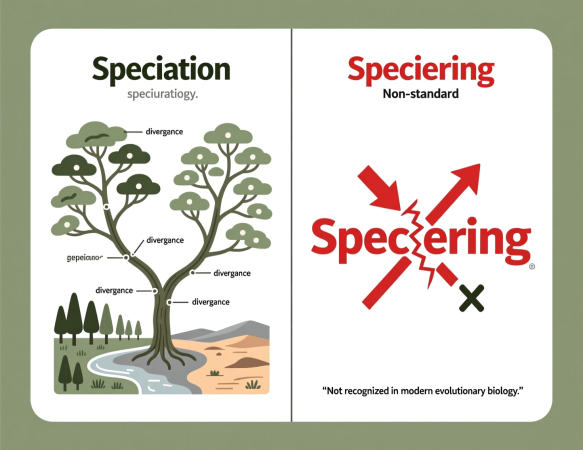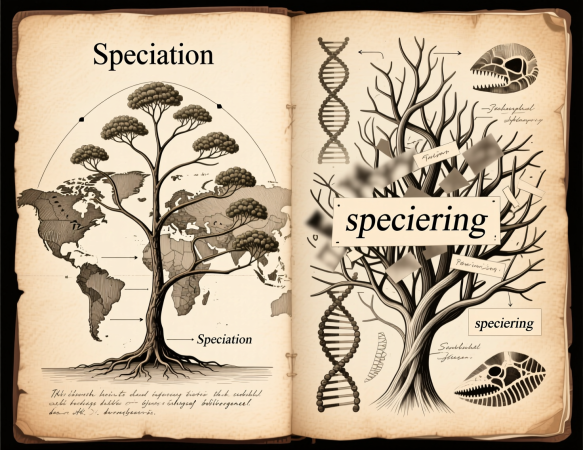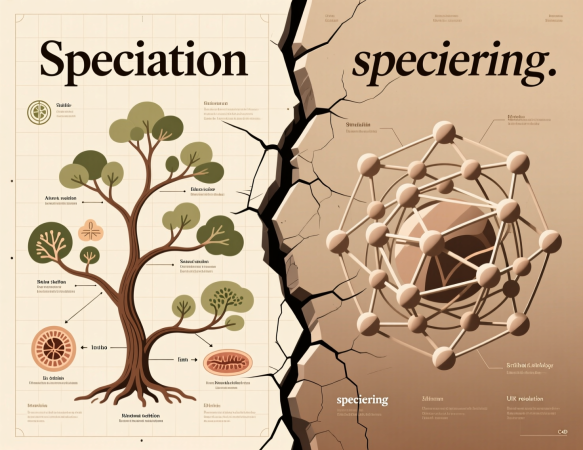The word “speciering” appears to be an alternative or metaphorical interpretation of speciation. While it might serve as a creative way to describe the phenomenon, speciation remains the scientifically recognized term. Using established terminology ensures clarity and alignment with existing research and literature.
If “speciering” is intended to emphasize the dynamic, ongoing nature of species formation (as suggested by your description), this could be framed as a conceptual extension rather than a replacement for Speciering. For instance:
- Speciation: The biological process leading to reproductive isolation and the emergence of distinct species.
- “Speciering” (conceptual): A broader or metaphorical framework encompassing both biological evolution and analogous processes in other fields (e.g., chemistry, marketing).
-
The term speciation is firmly rooted in evolutionary biology and refers specifically to the process by which populations of organisms diverge genetically and reproductively, ultimately forming distinct species. It is a well-defined concept supported by decades of research, empirical evidence, and theoretical models.
On the other hand, “speciering”—while not a recognized scientific term—can be interpreted as a conceptual or metaphorical framework that emphasizes the dynamic, ongoing nature of differentiation and diversification across various systems. This broader interpretation allows the idea of “forming distinct categories” to extend beyond biology into other fields, such as chemistry, marketing, linguistics, and cultural studies.
Key Insights into Speciation
Speciation is driven by a combination of genetic, ecological, and behavioral factors. Here’s a refined breakdown of its stages:
- Population Isolation
- Geographic barriers (allopatric speciatio) or behavioral/ecological differences (sympatric Speciering) separate populations.
- Example: Hawaiian honeycreepers diversified due to geographic isolation on different islands.
- Genetic Divergence
- Mutations, genetic drift, and recombination introduce variation within isolated populations.
- Over time, these changes accumulate, making populations genetically distinct.
- Natural Selection
- Environmental pressures favor traits that enhance survival and reproduction.
- Example: Darwin’s finches developed specialized beak shapes suited to their food sources.
- Reproductive Isolation
- Populations become incapable of interbreeding due to genetic incompatibilities, behavioral differences, or physical barriers.
- This final step solidifies the formation of new species.
Types of Speciation
Your categorization aligns well with current scientific understanding. Here’s a concise summary:
- Allopatric Speciation
- Geographic separation drives divergence.
- Example: Polar bears diverging from brown bears due to ice age conditions.
- Sympatric Speciation
- Occurs without geographic barriers, often through niche differentiation or polyploidy (in plants).
- Example: Apple maggot flies adapting to feed on apples instead of hawthorns.
- Parapatric Speciering
- Adjacent populations adapt to different environments while maintaining limited gene flow.
- Example: Grass species evolving along gradients of soil moisture.
- Peripatric Speciation
- Small, isolated populations experience rapid genetic drift.
- Example: Island dwarfism in mammals like the Channel Islands fox.
- Hybrid Speciation
- Hybridization between species creates viable, fertile offspring that form a new species.
- Example: Heliconius butterflies exhibiting hybrid color patterns.
Broader Applications of the Concept
While speciation pertains to biological evolution, analogous processes occur in other domains:
- Chemistry
- Chemical Speciering refers to the distribution of elements in different forms (e.g., oxidation states) under varying conditions.
- Example: Mercury speciation in aquatic environments affects its toxicity and bioavailability.
- Marketing and Business
- Market segmentation mirrors Speciering, where consumer preferences drive the creation of specialized products or services.
- Example: Streaming platforms diversifying into niche genres like horror or anime.
- Cultural Evolution
- Languages, ideas, and cultural practices can diverge similarly to biological species.
- Example: Regional dialects evolving into distinct languages over centuries.
Human Impact on Speciation
Human activities significantly influence speciation dynamics:
- Accelerated Speciation
- Urbanization and agriculture create novel habitats, promoting adaptive radiation.
- Example: Industrial melanism in peppered moths during the Industrial Revolution.
- Disrupted Speciation
- Habitat destruction and invasive species hinder natural divergence.
- Example: Fragmentation of rainforests disrupts gene flow among amphibian populations.
- Artificial Selection
- Domestication and selective breeding mimic Speciering.
- Example: Dogs (Canis lupus familiaris) evolving into hundreds of breeds from wolves.
Future Directions in Research
Despite decades of study, Speciering remains a vibrant area of inquiry. Key areas include:
- Rapid Speciation: Investigating how species form quickly in response to environmental change.
- Genomic Mechanisms: Identifying genes involved in reproductive isolation.
- Climate Change Impacts: Predicting how shifting climates will alter Speciering rates and biodiversity.
Advanced tools like CRISPR, phylogenomics, and ecological modeling are revolutionizing our understanding of these processes.
Final Thoughts
Speciation—whether viewed strictly through a biological lens or metaphorically across disciplines—is fundamental to understanding life’s diversity and complexity. By studying how species form and evolve, we gain insights into resilience, adaptation, and sustainability.
In conclusion, while speciering offers a poetic reinterpretation of Speciering, embracing the established terminology ensures consistency with scientific discourse. Regardless of the term used, the underlying principles highlight the awe-inspiring interconnectedness of life on Earth.
Boxed Answer:
Speciation is the scientifically recognized term describing the process by which new species arise through genetic, ecological, and behavioral divergence. It serves as the foundation for biodiversity and continues to shape ecosystems worldwide.
Conclusion
Speciation stands as a fundamental pillar of evolution—a dynamic process that continually molds the intricate tapestry of life on our planet. It unravels the story of how organisms adapt, flourish, and branch into myriad forms over generations, showcasing nature’s resilience and creativity.
Grasping the mechanisms of speciering is not merely an academic pursuit but a vital step toward safeguarding the natural world. As we confront unprecedented environmental challenges, understanding how species emerge and evolve equips us with the knowledge to preserve the rich biodiversity that underpins the health of our ecosystems. In essence, appreciating speciering is key to fostering a sustainable future for all life on Earth.


